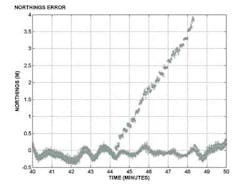GPS/INS fusion with Kalman filtering allows for better positioning
Kevin J. Delaney
BMT Scientific Marine Services
To ensure safe operation, floating ocean platforms normally contain systems that monitor the platform's position (latitude, longitude, and elevation) and attitude (roll, pitch, and yaw). Typically, these monitoring systems include one or more Global Positioning System (GPS) receivers along with rotation rate sensors and linear accelerometers.
For two reasons the measurements from these sensors must be combined to estimate attitude and position.
First, none of the desired variables (roll, pitch, yaw, latitude, longitude, and elevation) can be computed from a single measurement. For example, GPS receivers are affected by not only platform position, but also platform attitude, since the receiving antennas generally are mounted high above the water and move significantly when the platform rolls, pitches, or yaws. Similarly, the measured linear accelerations can be caused by shifts in platform position or by gravity if the platform is not perfectly level. Solving the platform motion equations—which link the desired variables with the available measurements—one at a time results in suboptimal state estimates.
Second, measurements must be combined because all sensors are subject to errors. Merely averaging sensor measurements in the face of such non-Gaussian errors is inadequate, while glitch rejection algorithms often fail to recognize errors which grow steadily.
The Kalman filter solves both problems. First, since the filter solves all platform motion equations simultaneously, it computes an optimal state estimate. Second, by inversely weighting each sensor's measurement by its noise level, the Kalman filter allows seamless handling of sensor errors.
BMT Scientific Marine Services has developed a system that applies adaptive Kalman filtering to the problem of combining GPS and Inertial Navigation System (INS) data. The system combines the output of multiple GPS receivers, gyros, and an INS into a best estimate of position and attitude. To eliminate false alarms caused by sensor errors, this system adaptively estimates sensor noise levels on a sample-by-sample basis, allowing the Kalman filter to discount measurements from faulty sensors—even those whose errors are not yet high enough to cause a rejection by conventional means. The system has demonstrated improvements in rejecting sensor errors and in reducing false indications that the platform is off desired position.
Development of the adaptive Kalman GPS/INS fusion system began with the extended Kalman filter, which applies basic Kalman state estimation theory to nonlinear models. This extension to nonlinear cases is required to consider platform attitude, as the relevant equations are all nonlinear. To ensure the system is free of attitude discontinuities, a quaternion attitude representation is used. In contrast to the typical Kalman model, in which state updates are added to the state estimate, quaternion state estimates are multiplied by their state updates, resulting in a Multiplicative Extended Kalman filter (MEKF).
A key question in using any Kalman filter is what value of measurement noise to use in the model. Not only is this value unknown, it may also be time-varying in which one GPS receiver is walks off its true location over several minutes, then snaps back into close agreement with the other two receivers. The fact that the three receivers have different—and time-varying—variances actually presents an opportunity to reject the noisy receiver. By adaptively estimating the measurement variances, we can weight the receivers according to their relative reliability, giving greater weight to the receiver with the lower variance. The Kalman measurement update accomplishes this automatically via the gain matrix computation. As a measurement channel becomes noisier, the gain applied to that noisy measurement goes down to give the noisy sensor less influence on the estimated state.
A conventional system which averages all the receiver positions produces the erroneous results, while the BMT adaptive Kalman system recognizes and rejects the error to prevent false alarms.
The BMT adaptive Kalman GPS/INS fusion processor provides the following advantages:
- Accuracy – Kalman filters are derived to minimize the mean-squared estimation error; tests confirm that the BMT adaptive Kalman system delivers lower RMS error than conventional GPS/INS fusion systems.
- Adaptive glitch rejection – Each sensor's noise variance is estimated on the fly from the data, allowing immediate recognition and rejection of faulty data.
- Fail-safe operation – Should sufficient sensors fail, making position estimation impossible, the system alerts the operator that the estimate is not being updated. Once sensors return to service, the system automatically continues normal operation.
- Speed – BMT's adaptive Kalman system runs in real-time.
- Fault rejection – The system rejects position and attitude state updates that exceed preset criteria, so simultaneous sensor failures cannot result in erroneous position estimates.
- Gimbal-lock free – All platform attitude (roll, pitch, and heading) computations are handled in quaternion space, guaranteeing seamless computation of rotations.
- Variable dimension – The BMT adaptive Kalman system automatically adjusts as sensors fail or are returned to service, on a sample-by-sample basis.

